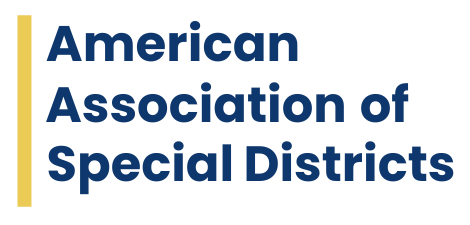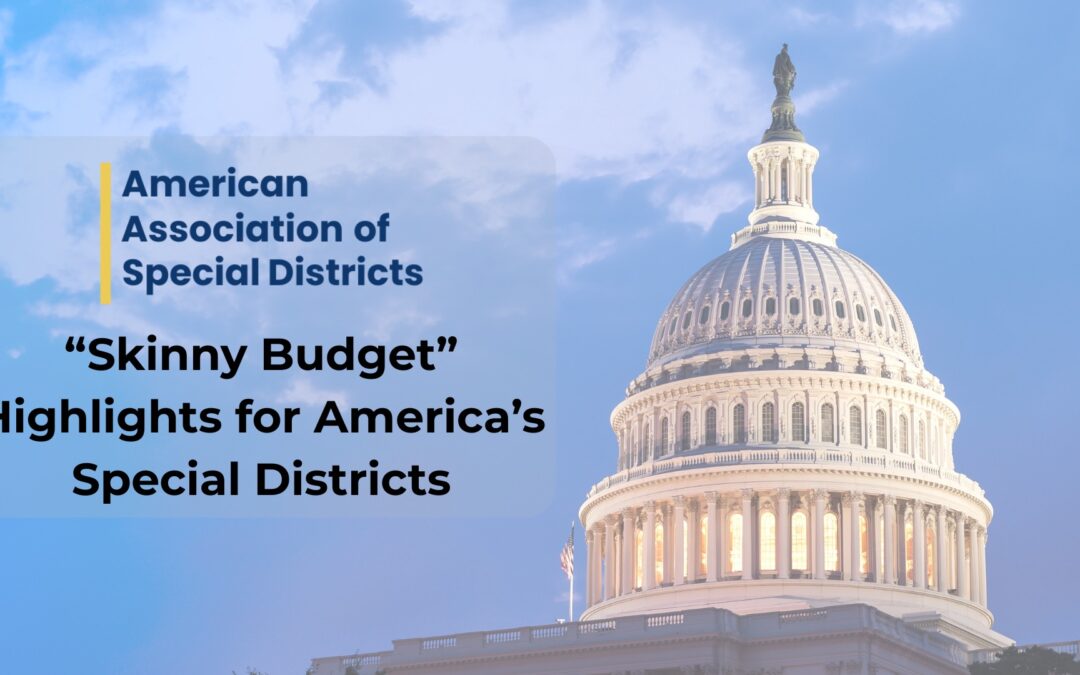This article first appeared Friday, May 16, 2025, in the Special Districts Download, AASD’s biweekly newsletter offering insights into federal and state trending advocacy issues, governance resources, and program updates.
The White House notified Congress of its Fiscal Year 2026 funding recommendations earlier this month, which Congress may use to inform its appropriations priorities for the year ahead. Within the so-called “skinny” budget request.
Topline & Context
The Trump Administration is seeking a 23 percent reduction in discretionary, non-defense spending based on FY25 with a shift in focus and increased spending on Defense and Homeland Security programs. Discretionary spending is the funding that Congress has full appropriations power over.
Examples of discretionary, non-defense programs range from major transit and transportation programs, such as Better Utilizing Investments to Leverage Development (BUILD); those that fund soil and water conservation efforts, including the Natural Resources Conservation Service; major water infrastructure programs such as the Clean Water and Drinking Water State Revolving Funds; as well as the Assistance to Firefighter Grant and much more.
Using federal FY23 spending for context: the Congressional Budget Office tallied $1.7 trillion in total discretionary spending (only $917 billion was non-defense) compared to $3.8 trillion in mandatory spending, which are programs that have been made permanent over time and are required to be funded. Congress has little authority to appropriate these funds. Examples of mandatory spending include Social Security, Medicare, and Medicaid.
Why are we calling it the “Skinny Budget”?
Office of Management and Budget (OMB) Director Russell Vought sent a letter to congressional appropriators on May 2 outlining highlights of the White House budget request. It’s skinny because the document is not as comprehensive as a traditional request (like this 2020 budget request from the then-Trump White House).
What’s in the FY25 Budget Document for Special Districts
The White House budget request (regardless of its skinny or fat status) does not have force of law, but rather just conveys the Executive Branch’s budget priorities.
A few of the President’s general priorities conveyed to Congress stand to impact programs that special districts’ direct/indirect program opportunities. Here is a brief rundown for special districts: highlights of selected programs included in the skinny budget, the White House’s proposed changes, and a brief synopsis of what it means for America’s Districts.
Water Utilities Infrastructure and Programs
The base budget request asks Congress to cut nearly (-)$2.5 billion in funding for the EPA Drinking Water and Clean Water State Revolving Funds (SRF). This is a critical fund many water and wastewater districts turn to for financing, via the state, for their infrastructure projects. Special districts can also tap into the fund for emergency measures such as backup generators for continuity of operations as well as for watershed programs. Vought told Congress in the memo SRF programs are duplicative of other EPA programs, such as the Water Infrastructure Finance and Innovation Act (WIFIA) or U.S. Department of Agriculture (USDA) Water and Wastewater Loan and Grant program. The letter also points to states’ responsibilities to fund their own community water and wastewater projects.
Further, the skinny budget asks for a (-)$1 billion reduction in EPA Categorical Grant programs that are aimed to help state and local governments comply with environmental regulations.
OMB is calling on Congress to appropriate (+)$9 million more for the Environmental Protection Agency (EPA) to mitigate water contamination and enhance response and recovery to disasters that impact drinking water quality. This is nearly an 8 percent increase over FY24.
Emergency Services & Public Safety
The White House is requesting a general (+)$43.8 billion increase for the Department of Homeland Security (DHS). Despite many security, emergency services, and prevention programs funded from DHS, the request is focused on border security and implementation of immigration policies.
Cybersecurity programs could see a (-)$490 million reduction, as the White House seeks to realign programs with what the Administration says should be the Cybersecurity Infrastructure and Security Agency (CISA) focused on. The request says the funds would look at censorship and first amendment issues.
Proposed Cuts to Conservation, Mitigation, and Rural Development Programs
(-)$721 million in cuts to USDA Rural Development have been pitched. This includes a full elimination of the Rural Development Community Facilities Grant program and no new funding for investment in rural broadband expansion. Salaries are also on the chopping block. Further, the request looks to streamline the rural water circuit rider program and prioritize rural water infrastructure.
The White House is calling for a (-)$392 million cut for U.S. Forest Service management programs but seeks to prioritize hazardous fuels reduction in a proposed reshuffling of dollars.
Also on the White House wish list is a (-)$303 million cut to state and private forest management programs geared toward state and local governments, and nonprofit groups. The document cites state and federal agency “impropriety” in managing the programs. “While the Budget provides robust support for federal wildland fire management activities alongside States and local partners, these partners should be encouraged to fund their own community preparedness and risk mitigation activities,” Vought wrote in the document.
Park & Recreation
The skinny budget calls for an 83 percent reduction to the National Recreation and Preservation Program, funded through the National Park Service, proposing around $15 million for the program (a [-]$77 million reduction) in FY26. The reason given for the substantial cut is the need to prioritize the backlog of National Park Service projects.
Further, the Administration criticized the Community Development Block Grant program, for which special districts are not directly eligible – pointing to a community skate park as an example of misused federal funds. The proposal would cut $3.3 billion from CDBG for FY26.
Our friends at the National Recreation and Park Association have a call to action for park stakeholders to share their support for full funding of authorized programs in FY26 following the skinny budget’s release. Check out more from NRPA here.
Port Infrastructure
Ports win in the budget request with a suggested infusion of (+)$550 million for the Port Infrastructure Development Program, but stand to lose with a proposed (-)$1.07 billion reduction in investments for the Harbor Maintenance Trust Fund.
Healthcare
The White House FY25 budget request calls for (+)$500 million in funding to advance the Make America Healthy Again agenda within the U.S. Department of Health and Human Services (HHS). According to the budget document, these funds would be leveraged to address “nutrition, physical activity, healthy lifestyles, over-reliance on medication and treatments, the effects of new technological habits, environmental impacts, and food and drug quality and safety across HHS.” This stands to have a potential indirect impact to health and hospital districts.
Energy Services
The skinny proposal calls for a (-)$4 billion cut to the Low Income Home Energy Assistance Program (LIHEAP) – essentially a full cut. This program has existed since 1981 as a block grant program for states to administer with the goal of preventing low-income Americans from losing utility services due to non-payment. The budget document states this federal program is unnecessary “because States have policies preventing utility disconnection for low-income households, effectively making LIHEAP a pass-through [program] benefitting utilities in the Northeast.” The report goes on to criticize New York and California for implementing the program in a fashion that raised home energy prices. Special districts providing energy services do not receive these funds directly but rather are often indirect beneficiaries of their low-income residents’ access to LIHEAP. Locally, residents can access assistance through organizations like community action partnerships or the United Way.
Conclusion
In all, proposed cuts to federal non-defense, discretionary spending stand to have a hit-and-miss impact on the universe of special districts. America’s districts’ leaders are encouraged to contact their members of the U.S. House of Representatives and U.S. Senate to express their favor or concern for elements of the budget proposal.
District leaders concerned about funding opportunities they have either subscribed to or are seeking to apply for are encouraged to contact their Member of Congress to support the programs in question.
Need help with your advocacy? Let us know! Email contact@americasdistricts.org for assistance.
Get highlights and updates like this on a regular basis. Give AASD a 90-day trial run at www.americasdistricts.org/application.

